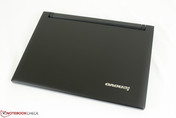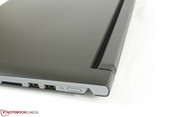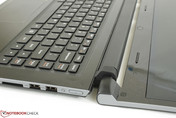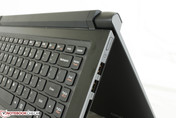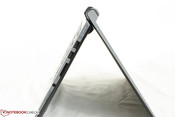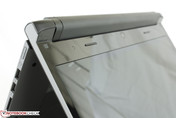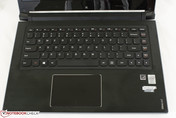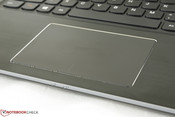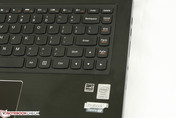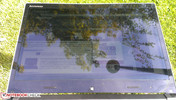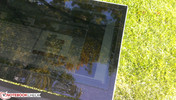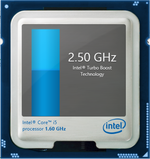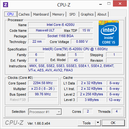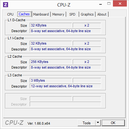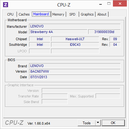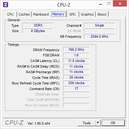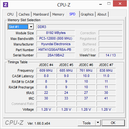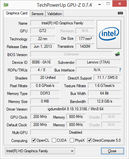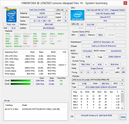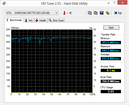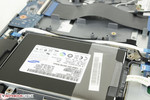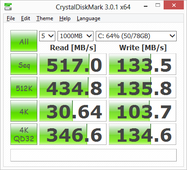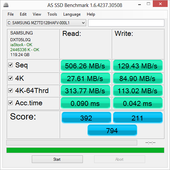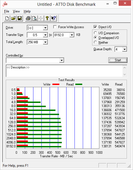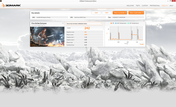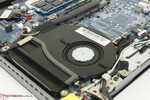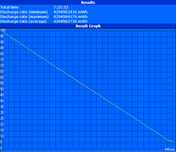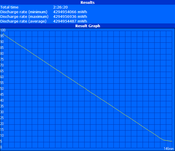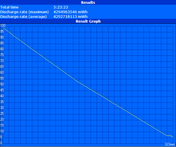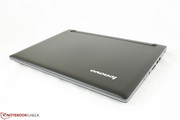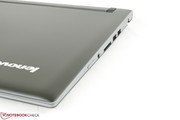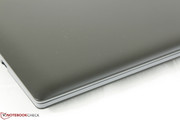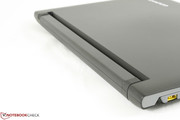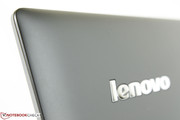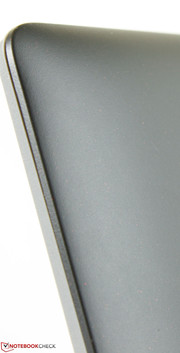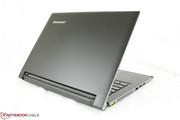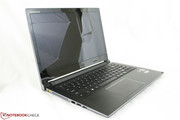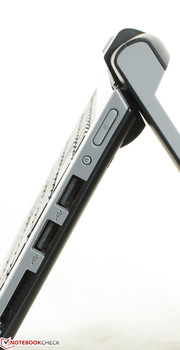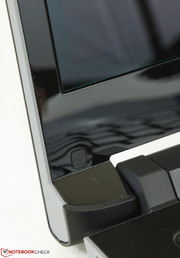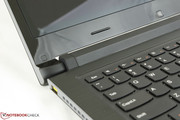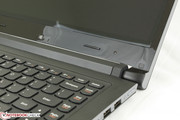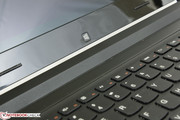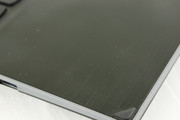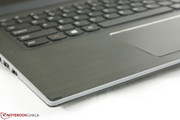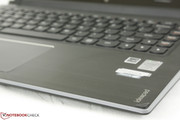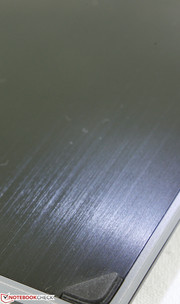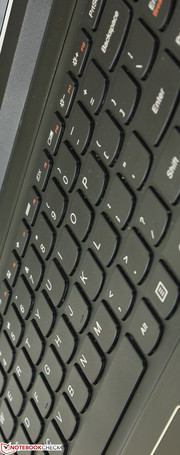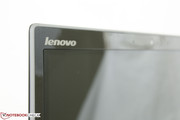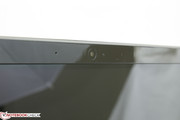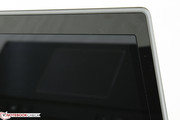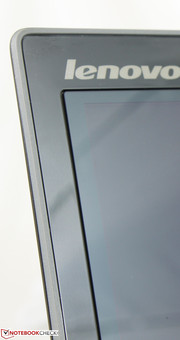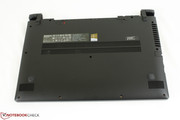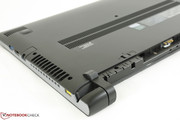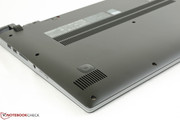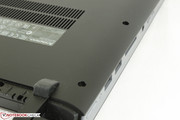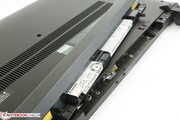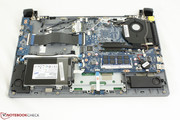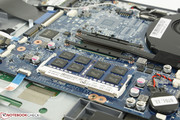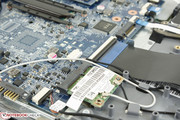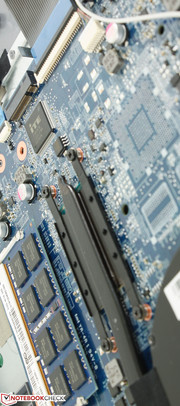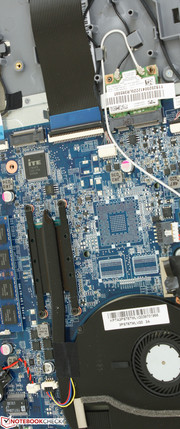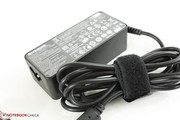Review Lenovo IdeaPad Flex 14 Notebook

The Yoga series made headlines when it was revealed early last year due to its 360 degree hinge; there's no denying that its slim form factor and bizarre modes made for eye-catching news images. The newer Flex series attempts to capture some of that wow factor at lower and more affordable prices for a wider reach. Starting at a base price of just $479, the Flex 14 is a potential option for users on a tighter budget.
The launch models all make use of an Intel Haswell CPU, 1366 x 768 resolution display and integrated HD 4400 graphics. Main differences between the models include the RAM and storage solution as simplified in the table below. The model in review is the higher-end Flex 14-59395991, which includes the mainstream ULV Core i5-4200U paired with a very speedy SATA III 128 GB Samsung SSD at a reasonable price of $749. Additional models are available for over $1000 with more powerful Core i7 options, but resolution remains unchanged throughout all models.
The $500 to $800 category is perhaps the most abundant and crowded with numerous common name competitors like the Aspire M5 series, Asus VivoBook series, HP Sleekbook series and Lenovo's own IdeaPad U series. We examine the Flex 14 below to see if the new Yoga-like family deserves a spot as your general household notebook.
| Model | Flex 14-59395495 | Flex 14-59393810 | Flex 14-59395501 | Flex 14-59395991 |
| Processor | 1.4 GHz Celeron ULT 2955U | 1.7 GHz Core i3-4010U | 1.6 GHz Core i5-4200U | 1.6 GHz Core i5-4200U |
| RAM | 4 GB | 4 GB | 8 GB | 8 GB |
| Storage | 5400 RPM 500 GB HDD | 5400 RPM 500 GB HDD | 5400 RPM 500 GB HDD | 128 GB SSD |
| U.S. launch price | $479 | $569 | $669 | $749 |
Case
Externally, the Flex 14 is similar to the 14-inch IdeaPad S400 or 15.6-inch S500. The case is mostly plastic with smooth brushed aluminum surfaces on the palm rests, rubberized matte on both the outer lid and underside and a thin glossy plastic for the inner display bezel. The three different type of surfaces may sound like a bit too much, but the jet black color scheme prevents the notebook from looking too eccentric. Meanwhile, the edges and corners are a duller dark gray as opposed to black on the S400 or S500. The design looks and feels great, especially for a sub $500 notebook, though the inner glossy bezel does appear more cheaply implemented in relation to the rest of the notebook. Be prepared to wipe off dust and fingerprints often.
Build quality is again good for the price. Pushing down on the center of the outer lid or twisting the lid side-to-side is still possible and visible as expected from a notebook in this category. The base, however, is quite rigid as only minimal depressions can observed when applying pressure on the center of the keyboard or palm rests. Twisting of the base is also possible, but very slight and not a cause for concern. The 21.6 mm thick Flex 14 isn't quite up to Ultrabook specifications, but it is still quite easy to mistake it as one due to the sleek appearance. Overall quality is similar to the Yoga 13 if not a little better, and notably superior to the larger and more powerful IdeaPad Y models.
With a name like "Flex", the Flex 14 had better utilize good hinges to be worthy of a purchase at all. Fortunately, the dual hinges here perform just fine no matter the angle. Closer inspection reveals hinges that attach from the sides of the base instead of on top like they do on the S400 or S500. This redesign allows for a stiff hold up to its maximum of about 300 degrees with negligible vibrations while typing. Users can make use of the Stand mode or Tent mode, similar to a Yoga model, though there is no tablet mode or automatic screen rotation for Tent mode. Even so, the hinges and overall visual design leave good impressions.
Connectivity
Connectivity is again similar to the S400 with 3x USB ports, HDMI-out and a dedicated Lenovo OneKey Recovery button. Port placement remains largely the same with both Power and Volume buttons now moved to the right edge to better accompany Stand mode. The Kensington lock is still absent, which suggests that the notebook was not designed to see much travel or outdoor use.
Note that Ethernet is up to 100 mbps and is thus not Gigabit compatible.
Communication
The Flex 14 includes a 2x2 (2.4 GHz and 5 GHz) Intel 7260 half-mini PCIe WLAN card capable of up to 867 Mbps with integrated Bluetooth 4.0. The hardware is compatible with ac bands, otherwise the bandwidth will be limited to the standard 300 Mbps for 802.11n networks. We experienced no connection or timeout issues when connected to a standard home network.
No models are available with SIM, WWAN or GPS functionality due to the target home audience and category of the Flex 14. Instead, Lenovo reserves such features for their more office-oriented ThinkPad series.
Maintenance
IdeaPads in general are not as end-user friendly as ThinkPads in terms of accessibility to internals. The bottom plate of the Flex 14 is user-removable, but will first require removing about a dozen screws and then carefully disengaging the plate from its base with a sharp edge.
Exposing the motherboard will reveal an internal setup very similar to that of the IdeaPad S500. Users get direct access to the 7 mm HDD, CPU fan, 1x SODIMM slot, heat sink, half-mini PCIe WLAN card and even an m.2 slot.
March 17, 2014 update: Our original review claimed that the Flex 14 housed an available mSATA slot. This has now been corrected to read m.2. Notebookcheck apologizes for the error.
Accessories
The lack of a dedicated docking port prevents any dedicated accessories for the Flex 14. This is an IdeaPad after all, so docking stations and special extensions are not the main focus of the series. Instead, Lenovo provides a plethora of general accessories like backpacks and multimedia accessories.
Warranty
The standard one-year warranty and 24/7 phone support apply to all new purchases. Lenovo offers extended options to include accidental damage protection and in-home service up to 3-years for a surprisingly low $99 premium.
Input Devices
Keyboard
The Chiclet keyboard (29 x 10 cm) is made up of evenly spaced keys with the familiar shape, layout and plastic feel that is common amongst most IdeaPad notebooks. On the Flex 14, however, the keys feel light in addition to the expectedly shallow travel. It doesn't take much force to press a key, which leads to below average feedback while typing. Like most other keyboards, it will take a little time before becoming fully accustomed to the feel of the keys. Beyond that, we applaud Lenovo for not reducing the size of the Arrow keys that are too often cramped and mushy.
When in Stand or Tent mode, the keys and trackpad are both automatically disabled in a manner not unlike the Yoga.
Touchpad
The smooth plastic touchpad is large (10.5 x 7.0 cm) for a 14-inch notebook while the chrome lining adds a luxurious feel to an otherwise completely black palm rests and keyboard. The surface is very slightly tilted; the front portion is raised higher than the back portion to allow for easier left and right clicks.
We had no issues using the touchpad for basic pointing-and-clicking with no random jumping or unresponsiveness. Multi-touch gestures like scrolling and zooming work especially well due to the large size and reduced delay. In fact, zooming can feel a bit too sensitive as a small input can result in a larger than intended zoom factor. The Synaptics ClickPad V1.1 software recognizes up to four-finger inputs and allows for a wide range of swipes and customizations.
Display
All Flex 14 models come equipped with a 1366 x 768 resolution glossy display. This resolution is common amongst budget notebooks of this size class and should be fit for general web browsing and word processing. If used for anything more, however, we would be craving for an option for higher resolutions. The Fit 14 and Lenovo's own IdeaPad U430 offer the more desirable 1600 x 900 resolution at the cost of higher sticker prices.
Subjectively, texts and images appear crisp, though underwhelming in colors and saturation. Individual pixels and a slight screen door effect are noticeable if viewing up close due to the larger pixels. On the bright side, the screen is almost plane to the surrounding bezel, which gives the desirable pop-up effect commonly found on mid-range to high-end tablets and smartphones.
Brightness is good at an average of about 200 nits. For a glossy display, however, this should have been much higher for more comfortable use outdoors where ambient lighting can be overwhelming. Measured contrast is well below 500:1, which is in line with similarly-priced models like the Satellite P845T and Aspire M5-481PT.
Note that the display is not protected by glass despite its touchscreen capabilities. Instead, it appears to be a thicker plastic that works almost as well, likely to keep costs low.
| |||||||||||||||||||||||||
Brightness Distribution: 84 %
Center on Battery: 177.9 cd/m²
Contrast: 323:1 (Black: 0.644 cd/m²)
ΔE ColorChecker Calman: 3.32 | ∀{0.5-29.43 Ø4.77}
ΔE Greyscale Calman: 2.42 | ∀{0.09-98 Ø5}
39.99% AdobeRGB 1998 (Argyll 1.6.3 3D)
43.2% AdobeRGB 1998 (Argyll 3D)
61.8% sRGB (Argyll 3D)
41.77% Display P3 (Argyll 3D)
Gamma: 2.47
CCT: 6944 K
Color reproduction is underwhelming at about 55.8 percent of sRGB or 40 percent of AdobeRGB 1998. This is to be expected from a budget-mainstream consumer notebook as precise color reproduction is typically reserved for more expensive models and workstations. Compared to the Vaio Fit 14 or IdeaPad U430 Touch, the Flex 14 exhibits a very similar color range. To the target audience and most home users, the limited color space is of little importance.
Further display measurements were performed with an X-Rite i1Basic Pro 2 spectrophotometer. With the display in its uncalibrated state, grayscale and color accuracy were very poor all-around. These properties improved dramatically after calibration as color temperature and gamma came closer to sRGB standards. Grayscale, for example, improved from a deltaE average of 13.71 to just 2.42.
Meanwhile, color accuracy improved on all saturation levels post calibration. Note that the colors generally become less accurate as saturation increases, especially for red and blue.
Outdoor usability is average at best when under shade. Otherwise, text and images will appear too dim even at the maximum brightness setting. The glare-heavy display worsens the problem as reflections are dominant and can be difficult to avoid. Note that maximum brightness will drop slightly if running on batteries, which further discourages outdoor use. In short, the Flex 14 was not designed to be an outdoor notebook.
Viewing angles are typical of a standard TN panel. Colors will quickly degrade if viewing from angles above the center normal and becomes less severe if viewing from the sides or from the bottom. This is where the notebook differs significantly from the IdeaPad Yoga as the Flex does not utilize an IPS display for more stable viewing angles. For Tent and Stand modes, however, the TN panel is sufficient.
Performance
The Flex 14 is available with a 1.4 GHz Celeron ULT 2955U in its lowest configurable model up to a 1.7 GHz Core i3-4010U or 1.6 GHz Core i5-4200U in the higher-end configurations. Regardless of the CPU, all options must be equipped with an ULV Haswell-based CPU and integrated HD 4400 graphics. Our particular review model uses the mid-range dual-core i5-4200U, which provides theoretical Turbo Boost performance up to 2.3 GHz for two active cores. The 15 W CPU performs similarly to its i5-3337U IVB predecessor despite running at slightly lower clock rates. For more information and benchmarks on the i5-4200U, see our dedicated page here.
RAM is provided by a single-channel PC3-12800 8 GB module from Hynix. There is only one SODIMM slot total.
Processor
CPU-oriented benchmarks place the i5-4200U in the Flex 14 in the same ballpark as other notebooks sporting the same processor, though unfortunately closer to the tail end. Super Pi 32M, for example, completes in 783 seconds, which is the slowest in our database of all tested i5-4200U processors. The multi-threaded wPrime 1024m benchmark is more respectable and closer to the average at about 710 seconds.
CineBench R10 and R11.5 CPU scores fare even worse as the Flex 14 comes out on bottom compared to other similarly-equipped notebooks. A potential cause is the weaker Turbo Boost as detailed in our stress test below, but most users will not notice the lesser performance in day-to-day tasks. Even so, overall average performance is on par with the IVB i5-3337U as expected.
System Performance
System performance according to PCMark 7 is very good at 4553 points. This puts the Flex 14 on the same level as the ultra high-end 2011 Alienware M18x (4579 points), though of course the final scores are heavily swayed towards systems with faster SSDs. The newer Vaio Duo 13 convertible also returned a very similar score of 4594 points, though this should be unsurprising given the very similar specs (i5-4200U CPU, HD 4400 GPU, SATA III Samsung SSD). According to PCMark 8, our Flex 14 provides a storage bandwidth of 180.44 MB/s.
Subjectively, system performance is very fast when navigating and multi-tasking between applications. Launching applications do not feel as instantaneous, but is fast and consistent nonetheless. While we can't speak for Flex 14 models shipped with 5400 RPM HDDs, our SSD-equipped model feels as quick as a standard SSD-equipped Ultrabook.
| PCMark 7 Score | 4553 points | |
| PCMark 8 Home Score Accelerated | 2726 points | |
| PCMark 8 Creative Score Accelerated | 2182 points | |
| PCMark 8 Work Score Accelerated | 4579 points | |
Help | ||
Storage Devices
Our review model includes a 128 GB Samsung SATA III SSD (P/N: MZ7TD128HAFV - 000L1). Less expensive configurations come with standard 5400 RPM 500 GB HDDs and likely suffer from slower system performance as a result. The drive is upgradeable and compatible only with 7 mm models. Like the IdeaPad S500 Touch, an mSATA slot is available for secondary storage options next to the half-mini WLAN card.
The most notable aspect of this particular Samsung model is its relatively flat write speeds across the board according to CrystalDiskMark. These speeds are significantly faster than the write capabilities of an Intel SSD 520 Series, but its 512K Write could have been better as other Samsung 830 models (like the MZ7PC128HAFU) can be almost twice as fast at over 250 MB/s in the same benchmark. See our growing list of HDD and SSD benchmarks here for better comparisons.
Graphics Performance
The integrated HD 4400 graphics is standard in a number of ULV Haswell models, including the i5-4200U. Compared to the HD 4600, the HD 4400 offers the same number of Execution Units, but operates at lower clock rates. For more information and benchmarks on the HD 4400, see our dedicated page here.
In synthetic 3DMark benchmarks, the Flex 14 returns a score (722 points) similar to the Latitude E7240 (725 points), which also uses the same CPU and GPU hardware. However, it is also notably lower than the similarly equipped Vaio Duo 13 (967 points) in the same 3DMark 11 benchmark and can even be outperformed by older models sporting the HD 4000 GPU and a faster CPU like the Fujitsu Lifebook E733 (725 points).
3D gaming on an integrated GPU paired with an ULV processor should raise red flags. While older and less intensive titles like Starcraft 2 are playable on low to medium settings, newer titles like Guild Wars 2 will struggle to produce playable frame rates on all but the lowest settings and resolution. Users looking for a more gaming-capable solution can consider the IdeaPad Y Series. Otherwise, the Flex 14 should be sufficient for older or less intensive titles and Flash-based games.
| 3DMark 03 Standard | 9129 points | |
| 3DMark 06 Standard Score | 4287 points | |
| 3DMark Vantage P Result | 3102 points | |
| 3DMark 11 Performance | 722 points | |
| 3DMark Ice Storm Standard Score | 31967 points | |
| 3DMark Cloud Gate Standard Score | 3719 points | |
| 3DMark Fire Strike Score | 523 points | |
| 3DMark Fire Strike Extreme Score | 242 points | |
Help | ||
| low | med. | high | ultra | |
|---|---|---|---|---|
| Guild Wars 2 (2012) | 31 | 9 | ||
| StarCraft II: Heart of the Swarm (2013) | 93 | 27 | 15 |
Emissions
System Noise
When completely idle and in Power Saver mode, the Flex 14 is essentially silent at a recorded 28.7 dB(A). Any light or moderate amount of work, however, can quickly bump fan speed up to the more audible 35 dB(A) range. This noise level is much more common than its silent 28 dB(A) range and is similar to what other notebooks in this size range experience. In general, the Flex 14 is quieter than the dual fans of the Yoga 13 during normal use.
Under very high or sustained maximum load, the fan speed of the Flex 14 will increase in a step-wise manner from 28.7 dB(A) to 36.1, 37.1, 37.8 and finally to 38.8 dB(A). This maximum fan noise is induced by intensive CPU or GPU tasks and is slightly louder than the ThinkPad S440 Touch, T440s and IdeaPad U430 Touch, but is still generally tolerable.
Noise level
| Idle |
| 28.7 / 28.9 / 29 dB(A) |
| Load |
| 36.1 / 38.8 dB(A) |
 | ||
30 dB silent 40 dB(A) audible 50 dB(A) loud |
||
min: | ||
Temperature
Idling surface temperatures stay below 30 degrees C on both the bottom and top quadrants. A clearer picture can be seen when under higher or maximum loads as the hot spots can be more easily identified. As suspected, the hottest quadrant is located on the bottom side of the notebook closest to the ventilation grilles. At a measured 44.6 C, this is much warmer than the surrounding quadrants, though certainly not as warm as the ATIV Book 5 or U430 Touch under the same conditions.
Note that one side of the notebook experiences almost no temperature change. Opening the bottom hatch to expose the motherboard reveals a large and hollow portion of the notebook. Thus, much of the generated heat will concentrate towards the CPU end of the notebook rather than the opposite side. This can lead to one hand or palm feeling warmer or cooler than the other when typing if the system is running high loads for longer periods of time. Otherwise, running daily or everyday tasks will not induce the high maximum load temperatures as recorded below.
(+) The maximum temperature on the upper side is 37.8 °C / 100 F, compared to the average of 35.4 °C / 96 F, ranging from 19.6 to 60 °C for the class Convertible.
(±) The bottom heats up to a maximum of 44.6 °C / 112 F, compared to the average of 36.8 °C / 98 F
(+) In idle usage, the average temperature for the upper side is 27.4 °C / 81 F, compared to the device average of 30.3 °C / 87 F.
(+) The palmrests and touchpad are cooler than skin temperature with a maximum of 29.8 °C / 85.6 F and are therefore cool to the touch.
(±) The average temperature of the palmrest area of similar devices was 27.9 °C / 82.2 F (-1.9 °C / -3.4 F).
Stress Test
We stress the notebook while running CPU-Z, GPU-Z and HWiNFO monitoring tools to identify any potential throttling or stability issues.
When running Prime95, the CPU was able to operate at a steady 2.1 - 2.3 GHz. The core was unable to maintain its advertised 2.3 GHz Turbo Boost, but the small and occasional 200 MHz drop should be hardly noticeable to home users.
When running FurMark, the integrated GPU ran at its full 1000 MHz speed for only the first half minute. Otherwise, the GPU was able to operate at a steady 600 - 750 MHz. It did on occasion top out at 800 MHz, though this was infrequent.
When running both Prime95 and FurMark simultaneously, the CPU immediately dropped to its base 1.6 GHz clock speed and never any higher. As CPU temperature reached 66 degrees C, the core would throttle to 800 - 900 MHz until CPU temperatures cooled to ~60 C. At this point, the clock speed would again bump up to 1.6 GHz until the cycle repeats. On the other hand, the GPU was observed to be steady at the 500 - 700 MHz range.
Our test above identifies CPU throttling issues with the Flex 14 when both the CPU and GPU are stressed simultaneously. Any Turbo Boost potential becomes nonexistent during this period. A 3DMark 11 run immediately following the stress test resulted in slightly lower scores across the board (591 GPU, 2529 Physics and 590 combined points post stress vs. 640 GPU, 2777 Physics and 634 combined points pre-stress). To most users, however, the minor CPU throttling should be unnoticeable as our test conditions are unrepresentative of everyday use.
When running on batteries, CPU and GPU performance will be reduced even on the High Performance profile. A 3DMark 11 run on batteries resulted in a GPU and Physics score of 575 and 1896 points, respectively. The significantly lower CPU score can be explained by the complete absence of Turbo Boost as the CPU was observed to be operating up to 1.6 GHz only.
Speakers
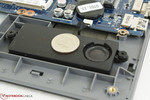
The stereo speakers are located on the bottom corners of the notebook closest to the user and face directly towards the table. The Dolby Advanced Audio v2 software allows for customizing and saving profiles for different media situations.
Sound quality is average and suffers slightly from the "tinny" quality normally associated with netbooks and small or inexpensive notebooks. The audio also feels hollow and bass is poorly represented. Maximum volume is still quite loud and will not result in audio distortions. It will, however, vibrate the notebook just slightly. External speakers via the 3.5 mm audio port are recommended for longer music or movie sessions.
Battery Life
A 4-cell Li-Ion (48 Wh, 3350 mAh) battery pack powers the Flex 14 with no larger models available at the time of review. The battery is easily removable from the back and occupies most of the rear.
Under minimum screen brightness with wireless radios disabled, we were able to record a maximum runtime of almost 7.5 hours using the Battery Eater Reader's Test. Similarly, maximum screen brightness with wireless radios enabled returned a minimum runtime of almost 2.5 hours using the Battery Eater Classic Test. Our more real-world WLAN test puts the notebook at 150 cd/m2 brightness (setting 9/10) while looping our browser script to simulate typical browsing conditions. Under these conditions, the notebook was able to last for almost 5.5 hours.
Lenovo promises "up to 9 hours battery life between charges", which we were unfortunately unable to replicate even at minimum screen brightness and Power Saver conditions. Instead, users should expect a more realistic 4 to 6 hours of continuous use depending on system load and settings, which is quite good for a notebook that starts under $500.
The 5.5 hour WLAN runtime is similar to the ATIV Book 5, IdeaPad U430 Touch and Aspire M5-481PT under the same conditions. Other notebooks like the Fit 14, Satellite P845T and VivoBook S400CA can last up to 2 hours shorter despite having similar battery capacities.
Verdict
The Flex 14 was made to be a a home or indoor notebook and it fits this category well. It is lighter than the IdeaPad U410 Touch Ultrabook with an arguably sleeker design and a good battery life for classroom or library work. System performance is fast, though we cannot speak for the less expensive models with the 5400 RPM mechanical drive. Even so, users can still opt for the lower-cost models and upgrade later as the internal RAM, HDD and mSATA slots can be accessed with a bit of patience.
Some aspects to keep in mind are the glossy display and average backlight, which prevent the Flex 14 from being a good outdoor notebook. The Stand and Tent modes are fun distractions at best and a novelty at worst. Cut corners include the move from IPS to TN and the removal of a glass surface.
CPU performance could have been better, though the ULV Core i5 is still sufficient for multi-tasking and other home tasks. Users running heavier programs for gaming or work may want to invest in another series (such as the ThinkPad or Y Series) as the 768p resolution display can feel too limiting too quickly. Hopefully future models will incorporate optional or even standard higher resolutions.
The Flex 14 is no ThinkPad or Latitude, nor does it try to be. Instead, it's an all-rounder and aggressively priced consumer touchscreen notebook that is both sleeker and less expensive than much of the competition.


